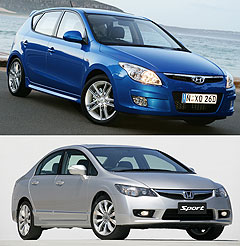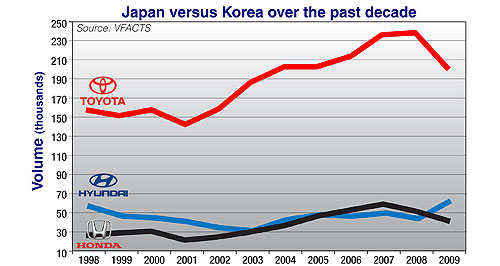Make / Model Search
News - General News - SalesHonda on a hidingDriveaway attack: The Honda Jazz Vibe adds features and an $18,888 driveaway price to help halt the brand's sales slide. Hyundai and Mazda sales soar at the expense of Toyota and Honda9 Mar 2010 THE rise and rise of Hyundai has been well documented by Market Insight, as has the Korean brand’s soaring sales success in 2009 relative to market-leader Toyota. Hyundai continues to surge ahead this year. After two months its sales are already up a staggering 70.9 per cent on the stellar figures it record in 2009 – a year in which Hyundai notched up a substantial 39.2 per cent sales spike, bucking a trend that saw the overall industry down by 7.4 per cent. In the same timeframe, according to official VFACTS sales figures from the Federal Chamber of Automotive Industries, Toyota’s 2009 sales decline of 15.9 per cent was greater than the industry average, although so far this year the nation’s top-selling brand is back in the black to the tune of 13.3 per cent. This is despite the fact Toyota sales were down 17.8 per cent in February, when Prius sales nosedived a worrying 52.3 per cent. The Avensis is the only other Toyota model to be down so far in 2010. However, another Japanese brand has fared even worse than Toyota since the global financial crisis struck in 2008, when Toyota sales grew by a meagre one per cent but Honda’s sales shrunk by 13.1 per cent.  Left: Hyundai i30. Below: Honda Civic. Left: Hyundai i30. Below: Honda Civic.Hyundai sales also fell, by 9.2 per cent, in 2008, but it was the last of three consecutive years in which Honda outsold its Korean competitor (52,571 sales to 45,409, while Toyota recorded its best-ever Australian sales result of 238,983 vehicles). That trend became even more pronounced in 2009, when sales of just 41,443 Hondas represented a 21.2 per cent sales slide, while Hyundai lodged an sales record of 63,207 vehicles to be up almost 40 per cent. Toyota meantime recorded its sixth straight 200,000-plus sales number, which was nonetheless nearly 16 per cent down year-on-year. Digging deeper, Honda’s (and Toyota’s) relatively old model line-up is at least partly responsible for its recent sales slump. Last year, sales of Honda’s Civic small-car decreased by 38.9 per cent to just over 10,000 vehicles, representing just 4.9 per cent of Australia’s largest single market segment. Meantime, while Toyota’s Corolla was also down (by 18.6 per cent) but held on to a narrow lead in the segment, sales of Hyundai’s i30 rose a staggering 110 per cent to claim equal third place. Similarly, while Honda’s one-time top-selling compact SUV, the CR-V, was down an unprecedented 48 per cent in 2009 (when just over 5000 examples were sold for a six per cent share), Hyundai’s direct rival – the Tucson – surged by 85.7 per cent to attract more than 11,400 sales and another third-place segment placing with a 13.5 per cent share. Hyundai’s Sonata had no answer for Honda’s Accord Euro in the mid-size model race last year, when sales of Honda’s Accord Euro were 7.7 per cent down, but that could change this year, when Hyundai launches its replacement in the all-new i45, then follows up in 2011 with the Europe-focussed i40. Honda clawed back some of its losses last month by being just 10 per cent down month-on-month, following a 48.5 per cent CR-V lift and a 245 per cent rise in Odyssey sales. But its woes appear to have continued in 2010 overall, when Honda sales are down 27.8 per cent, following poor year-to-date sales performances by the Legend (down 84.2 percent), Accord (down 47.4%), Jazz (down 36.2%), Accord Euro (down 28.7%), CR-V (down 25.6%) and Civic (down 22%). Meantime, sales of Hyundai’s new Santa Fe are up almost 175 per cent so far this year, while the i30 is up 128 per cent and the Getz is up 24.4 per cent. Off a lower base, the iMax and iLoad – for which Honda has no direct rival – are up a mammoth 184 and 329 per cent respectively. Naturally, it is the same story when it comes to market share. While Honda’s share of the Australian market peaked at 5.8 per cent in 2007 – the year more new vehicles were bought than ever before – it dropped to 5.2 per cent in 2008 and then just 4.4 last year. In 2009, then, Honda’s market share decreased by a significant 0.77 market share points, or 11,128 sales. Its share has plummeted further in the first two months of 2010, to just 3.9 per cent, representing a huge 2.27-point slide over the same period last year. Coincidentally, Hyundai’s market share increased by almost the same proportion (2.26 points) to 6.7 per cent in 2009, when its sales volume lifted by 17,798. So far in 2010, the market share of Hyundai (which outsold Ford to become the third best selling brand last month for the first time) stands at 8.5 per cent – a whopping 2.82 points up on the same period in 2009. Of course, it’s worth noting that Hyundai recent market share and sales records represent a return to the levels the Korean maker achieved in vastly smaller overall annual markets during the late 1990s, as the accompanying graph shows. Meantime, Toyota’s share peaked in 2008 at 23.6 per cent and dropped to a still-dominant 21.4 per cent last year, representing a 2.17-point or 37,992-vehicle decline in 2009. Toyota holds a 20.2 per cent share so far in 2010. But Hyundai was not the only top-ten brand to benefit from sales lost by Toyota and Honda last year. While Toyota and Honda were the biggest mainstream losers in terms of both sales and market share last year, the biggest winners were Hyundai and Mazda. Mazda, now Australia’s fourth best selling brand behind Toyota, Holden and Ford – and still well ahead of fifth-placed Hyundai – sold 2087 or 2.6 per cent fewer vehicles in 2009, but gained 0.41 market share points in a smaller overall market. Indicating that Toyota’s and Honda’s recent demise has come at the hands of both Hyundai and Mazda, the popular Japanese brand’s market share increased from 7.9 per cent in 2008 to 8.3 per cent last year, and stands at 8.7 per cent. Honda says its lacklustre 2009 fortunes came largely as a result of stock shortages, after the 2008 global industry downturn that led to production cuts in an effort to reduce overflowing worldwide stock inventories. “When the crisis hit we reacted very quickly by reducing stock levels,” Honda Australia spokesman Mark Higgins told GoAuto. “Running the car business is a bit like running a super-tanker – it’s hard to slow down and even harder to start up again. Part of the issue last year was lack of stock for a number of our key models … if people wanted certain models in a certain colour we simply didn’t have them.” While the long-awaited Insight hybrid will be its most important launch for 2010, Honda hopes a management reshuffle that has led to a renewed focus on limited-edition models will also boost sales this year. One example is the value-added Jazz Vibe, which was launched last month after a 56.6 per cent sales plunge for Honda’s light-sized hatchback in January. Originally priced from $17,740 for the entry-level GLi manual, the Vibe is now on offer from $18,888 driveaway. Following the hefty price cut for Honda’s new Jazz-based City sedan last year, driveaway deals now also exist as part of Honda’s ‘Summer of Love’ sale, which ends on March 31, for the Civic VTi (from $23,990 driveaway) and 2010 CR-V (from $33,990 driveaway). “There will be a number of limited-edition models throughout the year to increase the value proposition of our key models,” said Mr Higgins. “We’re very much in relaunch phase for the volume-selling CR-V and Civic, which have undergone an aggressive repricing and specification increase an, like our Accord models, now also come standard across the range with VSA (electronic stability control) and six airbags.”  Read more |
Click to shareGeneral News articlesResearch General News Motor industry news |










Facebook Twitter Instagram